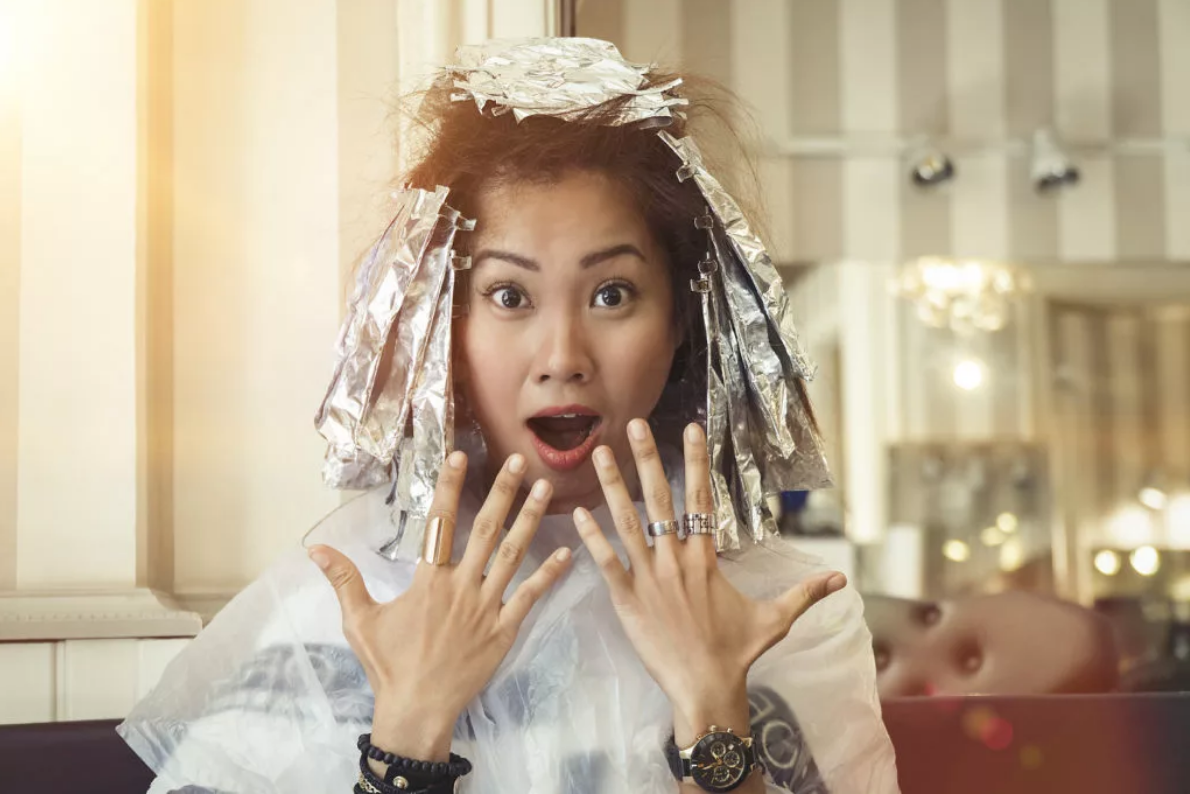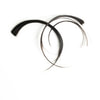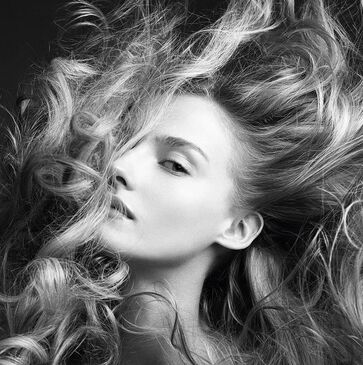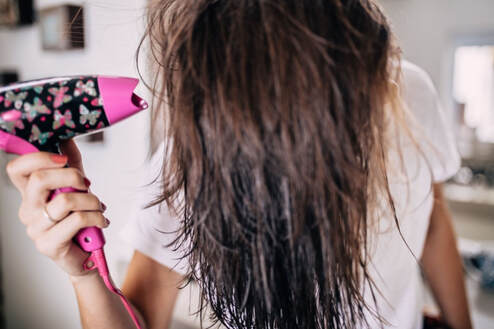|
Sound the myth busting klaxon; leaving your hair to dry naturally isn't better than using heat to dry it. It's actually less damaging to use a hairdryer, we learnt from Dr Tim Moore, Ghd's chief technology officer who has a PhD in Microelectronics from Cambridge University. "Natural drying takes a long time and water causes the cuticle to swell and crack, damaging the hair," he confirms. Interesting. In Ghd's research and development lab, where they spent £140,000 last year on hair swatches to test on for experimentation, Dr Moore explained that irreversible damage occurs when you style wet hair. So, what does this mean for your morning routine? To dry your hair without causing damage, follow these easy rules: 1. Towel dry your hair first Essentially you want to get your hair from wet to dry quickly, but without using high temperatures. Dr Moore says, "First you should towel dry your hair," by gently blotting, squeezing or scrunching the moisture out. Don't ruffle the hair with your towel, this in turn ruffles the cuticles which causes damage and visible frizz. 2. Don't brush your wet hair Brushing breaks wet hair. Fact. As dry hair is stronger than wet hair it can withstand brushing, so aim to use your brush once the hair feels touch-dry. Can't cope with the knots? Hair legend and Ghd's global brand ambassador Adam Reed says: "If you need to brush wet hair use a lubricant to provide slip." He favours an oil or a leave-in conditioner. If you start off without using a hairbrush and then find your hair becoming knotted, try his other tip. "Hit the hairdryer's cold shot and it will help to detangle hair, and use a Wet Brush." 3. Set your dryer to a low heat setting Until the water is evaporated off, Dr Moore says you should use a low or medium heat. "Stop and move on to another section when you feel the hair heating up." Just because hotter equals quicker when drying your hair, it doesn't make it better. "Take it slow," he adds. 4. When the hair is dry you can style it with heat Styling wet hair causes damage, so you always want to style the hair when it's dry – but keep a check on the temperature. "Styling hair above 210 degrees causes permanent damage," Dr Moore asserts. All Ghd tools are set to 185 degrees, "the best temperature to give enough energy to heat up hair quickly but avoid damage" – whatever your hair type. Burning your hair not only causes it to weaken, but the colour can fade or change, too. "Dyes are very sensitive to temperature," Reed adds. This information is from Harpers Bazar
0 Comments
No, you aren’t going crazy. That insane bacne bout you just experienced could have been caused by your conditioner. Our skin is our largest organ and anything coming into contact with it can change the way it functions. Before you throw your hands up in despair, read on to find out if your conditioner is causing your bacne. First things first, bacne is a colloquial term for acne affecting your back. It was coined in the internet age when people were trying to get a bit more granular with their problem area. Similarly to what happens with your face, anything that comes into contact with your back may cause it to breakout. Although we don’t realize it, products tend to wash off on us in the shower. Meaning, if you apply a heavy conditioner, when you rinse off in the shower the formula will undoubtedly make its way to your back on its way to the drain. Conditioners tend to be a common culprit in bacne cases because of the ingredients used to hydrate hair. Heavy oils and silicones are the biggest offenders. If you are prone to breakouts, you wouldn’t dream of putting a highly comedogenic (aka pore clogging) oil like coconut on your skin. Same goes for your back, yet we don’t pay attention to it in the same way. If your conditioner is loaded with comedogenic oils and hydrators, they will make contact with your back during your showers. The phenomena is so common that American Academy of Dermatology has a name for it, acne cosmetics. This term refers to a situation when your products are having secondary effect: nasty acne. If you notice a big change in your bacne after you start a new hair routine, educate yourself on the ingredients the new products have to make sure you can rule them out as the cause. If you are in the middle of a particularly bad bacne episode, reach for salicylic acid sprays that you can buy over the counter from many brands. This information is from Mane Addicts If you’ve ever given yourself a blowout, you know it doesn’t take much for it to go horribly wrong. In fact, there are certain things you should just avoid. While there’s nothing like attempting to uncurl an impossible kink to make you want to call it a natural day, don’t throw in the dryer just yet. By following our pro-guide on what to NEVER do (arguably more important than what you should do) when DIY’ing your blowout, we’re confident that the smooth silky locks of your hair dreams are just a brush, a heat protectant and a high setting away. Never Pretend Your Blow Dryer is a Wind Machine Blow drying is basically an art and a science. The first step in the perfect blowout is getting your form together—never just grab the dryer and go at it. “Never blow dry like Beyonce with a wind machine,” says SEVEN haircare Educator Kat Trotter-Viterbo. “You need control for a soft and shiny finish,” she stresses. Once your roots are dry, try using a paddle brush and dry the hair with the wind of the blow dryer going in a downward motion. “This will press the hair into a compact and shiny finish and help control flyaways,” she explains. Similarly (though it may feel very mosh-girl chic) never flip your head upside down. “Most people do this for volume,” Kat explains, however, this isolates the heat below the occipital bone (where your head starts to curve closest to your neck), which you don’t want to do. “That is the last place you want volume, and the toughest place to get it,” she says. To achieve volume, try blow drying the front of your hairline and top of your hair first, starting at the roots. PRO Beauty Tools Celebrity Stylist, Johnny Lavoy agrees. “Flipping your head over, or just aiming the blow dryer at the top layer of your hair can lead to over drying and even damage,” he says. Never Blow Dry Your Ends First“ Never ignore the roots!” cautions CHI Artist Cynthia Diersen. “Those need to dry FIRST before the rest of your hair since they hold the most amount of water.” “Never dry your ends first,” Kat adds. Because your ends are the driest and oldest part of the hair, they are likely to dry the quickest, due to its potential high porosity. “Try blow drying at the roots first,” she echoes. “This is the newest part of the hair and will allow you the maximum control in creating volume and a soft finish. Work your way through the ends last, allowing them to naturally dry through the process.” SEVEN Platform Educator, Tyson Daniel backs the importance of control. “Never blow dry your hair against the direction of your cuticle. This makes your hair frizzy and makes it harder to get a smooth, luminous look,” he explains. Though it may be frustrating (we’re in the struggle too, girl) never get aggressive with your hair. “When drying your hair, avoid twisting, wringing or aggressively drying. This disturbs the cuticle of the hair which results in frizzy styles or worse, damaged hair,” says Cynthia. Never Forget to Section For maximum control, make sure to section your hair. “Section your hair into 4 sections and start at the back,” says Cynthia. For best results, make sure you’re using the right brush. “Using a round or a paddle brush to dry the rest of the hair out, making sure each section is properly sealed with the heat of the dryer,” she continues. Johnny also swears by the power of sectioning. “Sections should be no wider than the barrel of the brush, unless you have curly hair. For curly hair, sections should be smaller (about half as wide as the barrel),” he advises. Never Forget Your Nozzle To make sure you are really controlling your heat and making the most out of your blowout, never dry without an air concentrator nozzle. “Using the nozzle gives a direct air flow, cutting down on drying time,” emphasizes Johnny. “Some of the worse breakage I’ve seen on hair is due to clients not using this attachment, which usually comes included with any dryer.” says Cynthia. Never Neglect Your Brush You definitely want to make sure you’re using the best brush for you. “For best results, use a round thermal brush,” says Johnny. “They come in a variety of sizes suitable for all hair lengths, but I personally recommend the PRO Beauty Tools Ionic Ceramic Thermal Brushes, $13.99” he explains. “The Ionic Ceramic Technology allows for even heat distribution, which helps eliminates frizz and adds shine. They come in two sizes – 1 ¾” and 2 ¼” – and also offer an extra-long barrel, which helps dry larger sections of hair faster,” he tells us. It’s also important to have a strategy when going in with your brush. “Never start round brushing your hair in the back while it is soaking wet, says Tyson. “It will take way too much time, and get frustrating by the time you get to the front of your hair.” Likewise, don’t put pressure from the end of a hot blow dryer directly on your brush, as this can cause super damage or, “put your hair in the line of fire,” Tyson describes. This is also where most heat damage happens on DIY blowouts, so beware! Never Hold Your Dryer Wrong You want to make sure your circulating around the hair—don’t stay on one section too long to avoid burning your locks. “Direct heat can cause damage, it’s important not to hold the dryer directly on their hair,” says Johnny. “For best results, make sure the blow dryer is constantly moving and working in the direction of the brush. You shouldn’t keep the hot air blowing on any part of your hair for too long. That leads to dryness, breakage and overall damage,” he cautions. Never Ignore the Heat Setting The heat setting you use is also dependent on your hair type. “Thicker hair can take higher temperature, but anyone with fine hair should be using a lower heat temperature,” Johnny explains. “Using the wrong heat setting can lead to over-drying,” he says. To preserve your blowout (you worked hard for it, it should last) go for the cold shot button. “It’s there for a reason, though many consumers don’t understand what the purpose of the cold shot button is. The cold shoot button helps set the hair for longer-lasting blowouts,” Johnny explains. Sealing with a dose of cool can also help close the cuticle and add shine. Never Skimp Or Skip On Product All of the pros agreed, forgetting or skimping on product, like a heat protectant, was a blowout death knell. “Never skip out on your thermal protector before the blow dry!” exclaims Kat. “Most hot tools (blow dryer included) can get as hot as 350 degrees. That’s hot enough to bake cookies or cook a chicken. You would never grab a cookie tray with your bare hands…so don’t do it to your mane,” she explains. Tyson agrees—there’s nothing worse than blowing out with just your dryer. “Never use cheap hair products or—even worse—nothing on your hair at all. It’s like going out into a windstorm naked. The product you go with can impact how the look of your style, so make sure to do your research. Always apply a product as a heat protectant and style aid. Cynthia shares. “I like to layer the following products for a weightless style with ultimate shine and protection: BioSilk Hydrating Therapy Pure Moisture Leave in Spray, $10.78 to detangle, followed by a few drops of the BioSilk Hydrate Therapy Maracuja Oil, $23.20. Brush the hair evenly and power dry up to 75% of the moisture out of the hair,” she recommends. Never Apply Product Too Close to the Scalp Even if you’re using the right product, never just goop it on, as this can have an adverse effect. “For hold, avoid using heavy finishing sprays or using them too close to the hair. Instead use sprays that allow for flexibility after multiple layers like our CHI Royal Treatment Ultimate Control Hairspray, $9.80,” says Cynthia, to gain control of how little or how much hold you want to have in your finished style. “Spray at least 6-8 inches away from the hair to avoid the ‘wet’ look in your finish,” she adds. Melissa Peverini, Marula Pure Beauty Oil Brand Ambassador, tells us that product placement is just as important as where you place your dryer. She recommends the Marula Pure Beauty Oil 5-in-1 Volume Spray, $28.40, however, at a distance. “Avoid spraying too close to the roots on wet hair,” she says. Keep the products about 6” away from the scalp as too much can create sticky roots during your blowout. If you’re using an oil (she swears by Marula Pure Beauty Oil Hair Treatment & Styling Oil, $26) try not to use more than 1-2 pumps at a time. “A little goes a long way for wet or dry hair,” she says. Again, avoid your roots. “This is the healthiest part of the hair, so apply mostly on the mid-shaft and ends where hydration and shine are needed, prior to your blow-out,” adds Melissa. Never Downplay Your Prep A great blowout starts with a thorough hair cleansing. “Avoid over the counter products that are filled with waxes and silicones,” says Cynthia, who advises to have an idea of what’s in products before buying. “Talk to your professional stylist and trust their recommendations. They might come at a slightly bigger investment, but professional products are concentrated so you use less of them per application and you gain more benefits!” Also, never go overboard when you condition. “Never use too much conditioner or apply it too close to the scalp,” she explains. It can be tough to hold back, but your blowout depends on it! “People tend to apply too much and too close to the scalp, which is a waste of product and results in limp and greasy looking styles” she says. Never Rush It Although you may be low on time, make sure you see all the steps of your blowout through. “When we’re in a hurry we tend to ‘do what it takes’ to get out of the door on time,” Cynthia says of our relatable morning, however, don’t just freestyle! “If you’re in this situation, avoid putting your hair in a tight ponytail when your hair is too wet. The hair needs to have time to dry and revert to its natural shape. When wet, it’s loaded with water which makes it stretch out to its maximum capacity. If we don’t allow it to shrink back to normal, it can snap from tension spots in the ponytail,” she explains. Not rushing it is most important thing to remember in the long list of blowout don’ts, according to Tyson. “Never be in a hurry. It’s better to set aside the right amount of time and do it right,” he says—which are pretty much all around words to live by. Your blowout: your life. This article is from Mane Addicts
A Healthy and Clean Scalp is the key to thick, shiny, gorgeous hair.
If your scalp is unhealthy, inflamed and full of toxins, imagine what quality of hair will it grow. Dull, thin, weak that falls out easily. Like the delicate rose plant which requires the right moisture, soil pH, and nutrients to grow and flourish, our hair too is very demanding. It needs the right conditions to grow, especially the hair on the scalp. It’s a real tough cookie to crack. Sadly in the quest to make our hair look beautiful, we are exposing it to an onslaught of chemicals. Everyday use of hair dyes, mousse, sprays, shampoos and conditioners only makes the matter worse. And it’s not your fault. The flashy advertisement and glossy models lure you in the promise of thicker, fuller and shinier hair. And most of us switch from one product to another only to be left in more hair misery. Even if you opt for natural hair care, the pollution and water quality is another factor you can’t do much about. Unless we all live in the forest and use pure spring/river water, which would be so lovely. But if you are a city inhabitant, you can give yourself a scalp detox every so often. A scalp detox is like doing a deep cleanse. It helps to remove toxins and gunk from the scalp, unclogs the hair follicles, and balances our natural oils and scalp pH. Detoxing your scalp will rejuvenate and renew the hair follicles and create a perfect environment for hair growth. Why detox your Scalp and Hair?
7 Ways to Detox Your Scalp and Hair Scalp Detox does sound fancy, but you don’t need to go to the spa to get this done. You can give yourself a scalp detox right at your home, with simplest possible ingredients. Choose from following options:
 I’m sure you’ve done a fair share of internet searches on what type of hair you have and what types of products you should use, based on your hair type—but did anyone ever tell you what products or ingredients to stay away from? I know it can be annoying to have to read through the ingredients list plastered on the back of the bottle in such teeny tiny print, but if you can just scan for these ingredients, you will save time and your hair will thank you. Curly Hair: Alcohol + Mineral oil/ Petroleum What differentiates your hair from being naturally curly or straight is the shape of your hair follicle. Typically, a curved follicle is what creates curly hair as opposed to round follicles, which are found in people who have straight hair. Curly hair types are prone to being very dry because it’s harder for natural oils to travel down the hair for hydration. So when looking for products for your curly hair, stay away from alcohol which will strip your hair from that extra moisture you need. Another sneaky ingredient to stay away from is mineral oil or petroleum. These two can be deceiving because you think this will seal your hair with moisture, but it is quite the opposite. Mineral oil and petroleum will actually block any moisture from being absorbed into your hair. So don’t be fooled! Fine hair: Oil + Sulfates People who have fine hair have lower hair density which means they have a lower count of hairs on their head per square inch, compared to people with normal or thick hair. The average amount of hairs on a human head is 2,220 hairs per square inch and anyone with more than that is considered to have thicker hair. For fine haired people, this means that you hair is more susceptible to getting oily faster because your scalp naturally produces oils to keep your skin and hair moisturized and since there are less hairs on your head, there is more oil that is being distributed to each strand on your head. So, with all this talk of oil, the main ingredient you want to avoid is, of course, oil. Applying products to your hair with lots of oil will only seal in the oils that are being produced on your head which will weigh down your hair and make it appear flat and just plain greasy. One more ingredient fine haired people should avoid are sulfates. Sulfates help get your hair clean, but it mostly strips your hair of strengthening proteins and can slow down and even stop the growth of your hair. With already less hair on your head, the last thing you’d want is your hair to stop growing! Chemically treated hair: Diethanolamine (DEA) + sodium chloride If your hair is chemically treated, there is already a lot more damage that is done to your hair as well as your scalp. Your hair is basically stripped of all of its nutrients and proteins which means you need to be more conscious of what ingredients are in your products because as you know, there are lots of ingredients out there that help “get the job done,” but can cause more damage to your hair and scalp with prolonged use. Diethanolamine (DEA) and sodium chloride are two of the main ingredients you should avoid. The ingredient DEA is used mostly in shampoos to create the foaming suds when you lather your hair in the shower. It is also found in brake fluid and antifreeze—yikes! If you have sensitive skin, DEA can also cause scalp irritation. The other ingredient to stay away from is sodium chloride; better known as salt. It strips away moisture that your hair desperately needs each time you go to the salon for a color touch up. Sodium chloride can leave your scalp feeling itchy and dry which can lead to irritation, flakiness and also promote hair loss. Your hair is already put through so much when you decide to treat it chemically, so it’s important to pay close attention to your aftercare! This article is from Mane Addicts |
Hair by BrianMy name is Brian and I help people confidently take on the world. CategoriesAll Advice Announcement Awards Balayage Barbering Beach Waves Beauty News Book Now Brazilian Treatment Clients Cool Facts COVID 19 Health COVID 19 Update Curlies EGift Card Films Follically Challenged Gossip Grooming Hair Care Haircolor Haircut Hair Facts Hair History Hair Loss Hair Styling Hair Tips Hair Tools Health Health And Safety Healthy Hair Highlights Holidays Humor Mens Hair Men's Long Hair Newsletter Ombre Policies Procedures Press Release Previous Blog Privacy Policy Product Knowledge Product Reviews Promotions Read Your Labels Recommendations Reviews Scalp Health Science Services Smoothing Treatments Social Media Summer Hair Tips Textured Hair Thinning Hair Travel Tips Trending Wellness Womens Hair Archives
June 2025
|
|
Hey...
Your Mom Called! Book today! |
Sunday: 11am-5pm
Monday: 11am-6pm Tuesday: 10am - 6pm Wednesday: 10am - 6pm Thursday: By Appointment Friday: By Appointment Saturday: By Appointment |





 RSS Feed
RSS Feed